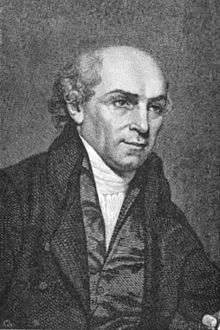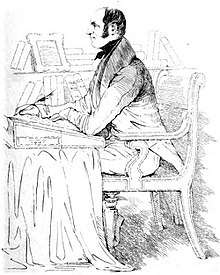Serampore College
Serampore College is located in Serampore, in West Bengal state, India. Established in 1818, it is the second oldest college in the country after Presidency College Calcutta, and one of the oldest educational institutes in India that is still functional.[1] The college consists of two entities: The theological faculty and a separate college with faculties of arts, science, commerce.
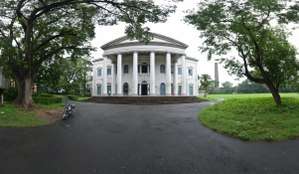 | |
| Motto | Latin: Gloriam Sapientes Possidebunt |
|---|---|
| Established | 1818 |
| Principal | Dr. Vansanglura |
Administrative staff | 79 (teaching), 30 (non-teaching) |
| Students | 2,277 |
| Location | 22.7519011°N 88.3512874°E |
| Campus | Urban |
| Affiliations | Senate of Serampore College (University) and University of Calcutta |
| Website | www |
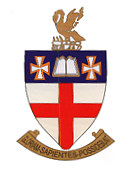 | |
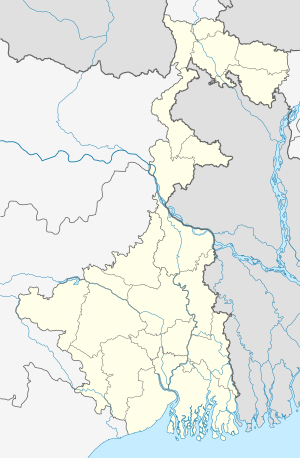 Location in West Bengal  Serampore College (India) | |
| NAC 2004 report on the College and its degree issuing position | |
The Senate of Serampore College (University) runs the academic administration of all the theological colleges affiliated with it. The council of Serampore College holds a Danish charter and had the power to confer degrees in any subject, which it currently exercises only for conferring theological degrees as recommended by the senate.[2]
Degrees are awarded for arts, science and commerce students of the Serampore College by the University of Calcutta.[3]
For theology, the college is affiliated to the Senate of Serampore College (University). Several theological colleges and seminaries all over India including Nepal, Bangladesh and Sri Lanka are affiliated to the Senate of Serampore College (University).
The present principal is Dr. Vansanglura.
Motto
The college motto is from Proverbs 3:35 in the Vulgate: Gloriam Sapientes Possidebunt, "The wise shall possess glory."
Authority to issue degrees and accreditation
The Serampore Trio - William Ward, William Carey, & Joshua Marshman, started the college with 37 students in 1818.[4] King Frederick VI of Denmark[5] originally granted a Royal Charter giving Serampore College the status of a university to confer degrees on 23rd February 1827.[6] It became the third Danish University after the ones in Copenhagen and Kiel.[7] With the later establishment of the University of Calcutta in 1857 the arts, science and commerce parts of Serampore College were affiliated to the University of Calcutta. However, Serampore College still today continues to enjoy the privilege of conferring its own degrees in theology under the power vested by the Charter and Act of Serampore College. It is a private Grant-in-aid Minority College and is recognized by the University Grants Commission under Section 2(f) and 12(b) of the UGC Act, 1956.[8]
History
Founding by English missionaries
Serampore College is the oldest university in India to be in continuous operation.[9] It was founded in 1818 by the English missionaries known as the Serampore Trio:[10]
Their aim was to give an education in arts and sciences to students of every "caste, colour or country" and to train people for ministry in the growing church in India (See: Christianity in India).
From its beginning the college has been ecumenical but this means that it has no automatic basis of support from any one branch of the Christian church. Prior to 1818, the Serampore Trio had worked together in providing education for their own children and the children, including females, of the native Indians.
Original charter from Denmark
Since Serampore was then a Danish colony, King Frederick VI, the King of Denmark, issued Serampore College its Royal Charter of Incorporation on 23 February 1827, in Copenhagen, Denmark (Charter, 1, Charter, 2, Charter, 3). The charter came in response to Joshua Marshman's visit to King Frederick in August 1826; the charter gave Serampore College the privilege of awarding degrees in arts and theology.[11] William Carey, Joshua Marshman and John Clark Marshman (Joshua's son) were designated as members of the first council. At its opening, the Serampore Trio released a prospectus which proposed "A College for the instruction of Asiatic Christian and other Youth in Eastern Literature and European Science." The college was open to all people of any caste or creed, and the founders ensured that no denominational test would apply to faculty members. The charter has also been confirmed by the Bengal Government Act IV of 1918.
The status accorded by the Danish charter has since been reaffirmed for the study of theology and now forms the basis for degrees of all levels conferred by over forty theological colleges throughout India and is administered by the senate. It was incorporated by Royal Charter in 1827 and the Bengal Government Act IV of 1918.
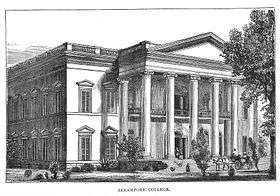
Control passed back to the British
After 22 February 1845 when Denmark sold all of its Indian assets to Britain the management and operation of the college continued without interruption under the direction of a master and council. In 1856 the Baptist Missionary Society in England took over the management of the college and, in 1857, the college became affiliated with the newly established University of Calcutta and became a constituent college of that university. In 1883 the college closed as an arts college and began functioning as a Christian Training Institution and a theological institute for the Baptist churches in Bengal. Affiliating again with the University of Calcutta in 1911, Serampore College, in 1913, was authorised to award the Bachelor of Arts degree. The college faculty was interdenominational.
Twentieth century
On 4 December 1915, the first group of Bachelor of Divinity students graduated:
- The Reverend I. W. Johory, Professor in the Canadian Mission College, Indore;
- The Reverend N. G. Kuriakos, a priest in the Orthodox Syrian Church; and
- Mr. D. M. Devasahayam, London Missionary Society, South India.
Between 1916 and 1927, sixty-nine further students earned their Bachelor of Divinity degrees through Serampore College.
During the centenary year of the college, in 1918, the Bengal Legislative Council passed the Serampore College Act (1918 Act, i, 1918 Act, ii, 1918 Act, iii, 1918 Act, iv) for the purpose of enlarging the college council and forming a new interdenominational senate that would confer theological degrees for all Christian denominations in India. By 1960 twenty other Indian colleges and seminaries affiliated themselves with Serampore.
The name of the college and its founders are honoured today more widely than just within Christian circles – the Carey Library at Serampore houses 16,000 rare volumes and is used by scholars from across the world.
Principals
| Years | Name | Academic credentials |
|---|---|---|
| 1818–1832 | ✝William Carey | |
| 1832–1837 | ✝Joshua Marshman | D.D |
| 1837–1845 | ✝John Mack | |
| 1845–1858 | ✝W. H. Denham | |
| 1858–1879 | ✝John Trafford | B.A. (Glasgow) |
| 1879–1882 | ✝Albert Williams | B.A. (Glasgow) |
| 1883–1906 | ✝E. S. Summers | B.A. |
| 1906–1929 | ✝George Howells | Ph.D. (Tübingen) |
| 1929–1949 | ✝G. H. C. Angus | M.A. |
| 1949–1959 | ✝C. E. Abraham | M.A. The First Indian Principal |
| 1959–1966 | ✝William Stewart | M.A. |
| 1966–1968 | ✝S. J. Samartha | Ph.D. (Hartford) |
| 1968–1969 | A. K. Mundle | M.A. |
| 1969–1972 | M. N. Biswas | M.A. |
| 1972–1976 | S. K. Chatterjee | M.A. |
| 1976–1977 | R. L. Rodrigues | M.A. |
| 1977–1987 | S. Mukhopadhyay | Ph.D. |
| 1988–1989 | T. K. Swarnakar | M.A. |
| 1990–1998 | J. T. K. Daniel | Ph.D. (Madras) |
| 1999-2011 | Lalchungnunga | Ph.D. (NEHU) |
| 2011-2015 | Laltluangliana Khiangte | Ph.D. (NEHU) |
| 2015-present | Vansanglura Vanchhawng | Ph.D. (Mizoram) |
Honours
On 7 June 1969, the Indian Department of Posts issued a stamp[12] and a first day cover[13] depicting Serampore College. In 2017, to commemorate the bicentennial anniversary of the University, Denmark’s ambassador to India, Mr. Peter Taksøe-Jensen announced that the Danish Government decided to grant 18 outstanding students of Serampore College through the King Frederik VI Scholarship.[14]
History

Since Serampore was then a Danish colony, King Frederick VI, the King of Denmark, issued Serampore College its Royal Charter of Incorporation on 23 February 1827, in Copenhagen, Denmark (Charter, 1, Charter, 2, Charter, 3). The charter came in response to Joshua Marshman's visit to King Frederick in August 1826; the charter gave Serampore College the privilege of awarding degrees in Arts and Theology. William Carey, Joshua Marshman, and John Clark Marshman (Joshua's son) were designated as members of the first Council. At its opening, the Trio released a prospectus which proposed "A College for the instruction of Asiatic Christian and other Youth in Eastern Literature and European Science." The College was open to all persons of any caste or creed, and the founders ensured that no denominational test would apply to faculty members. The charter has also been confirmed by the Bengal Govt Act. IV of 1918.
The status accorded by the Danish Charter has since been re-affirmed for the study of Theology[15] and now forms the basis for degrees of all levels conferred by over forty theological colleges throughout India, and is administered by the Senate.It was incorporated by Royal Charter of 1827 and Bengal Government Act. IV of 1918.
See also
References
- Seven oldest universities in India: All you need to know
- World Council of Churches, Ministerial Formation, July 2003. Retrieved 23 April 2006.
- Education Info India Colleges under University of Calcutta, July 2003. Retrieved 23 April 2006.
- http://www.hooghly.gov.in/ser_hist.htm
- http://seramporecollege.org/a-s-c/about/history/
- http://seramporecollege.org/a-s-c/about/council/
- https://en.natmus.dk/historical-knowledge/research/research-projects/the-serampore-initiative/historical-background/
- "UGC Act-1956" (PDF). mhrd.gov.in/. Secretary, University Grants Commission. Retrieved 1 February 2016.
- List of oldest universities in continuous operation#Asia
- "The Story of Serampore and its College". mergingcurrents.co. p. IVth edition 2006 page 174. Archived from the original on 22 October 2003.
- http://councilofseramporecollege.org/
- Postal Stamp
- First Day Cover
- https://indien.um.dk/en/news/newsdisplaypage/?newsid=040ce50a-f794-40f1-962e-5d3dcd1e1402
- Sankar Ray, The Hindu (Business Line), 11 April 2008 Almost a century later, the charter was endorsed officially under the Bengal Govt Act IV of 1918.
Further reading
- John Clark Marshman (1859). "The Life and Times of Carey, Marshman and Ward". I & II. Cite journal requires
|journal=(help) - J.T.K.Daniel and Roger E. Hedlund (1993). "Carey's Obligation and India's Renaissance". Cite journal requires
|journal=(help) - Sunil Kumar Chatterjee (2006). "Hannah Marshman - The first woman missionary in India". Cite journal requires
|journal=(help) - Sunil Kumar Chatterjee (2002). "Family Letters of Dr. William Carey". Cite journal requires
|journal=(help) - Sunil Kumar Chatterjee (2005). "William Carey - The Father of Modern Missions in the East" (New Edition). Cite journal requires
|journal=(help) - Sunil Kumar Chatterjee (2004). "William Carey and Serampore" (2nd Edition). Cite journal requires
|journal=(help) - Sunil Kumar Chatterjee (2001). "John Clark Marshman (a trustworthy Friend of India)" (2nd Edition). Archived from the original (– Scholar search) on 26 August 2004. Cite journal requires
|journal=(help) - The Council of Serampore College (2006). "The Story of Serampore and its College" (Fourth Edition). Archived from the original (– Scholar search) on 22 October 2003. Cite journal requires
|journal=(help)

